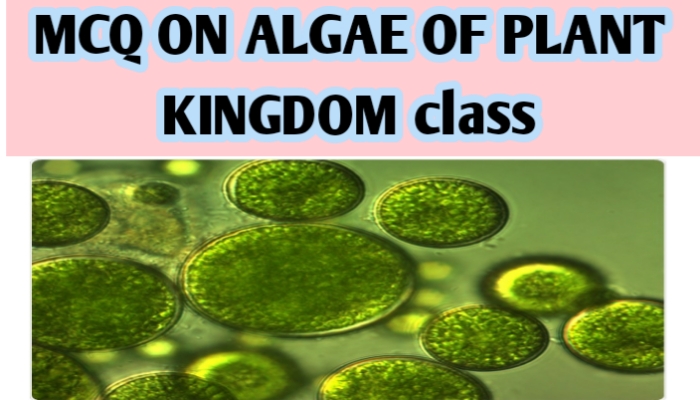MCQ ON ALGAE OF PLANT KINGDOM class 11 for NEET | MCQ ON NEET Biology class 11th 2022 | MCQ Questions for class 11 Biology chapter -3 , ALGAE OF PLANT KINGDOM with answers | Check the below NCERT MCQ Questions for class 11 Biology chapter 3 based on ALGAE OF PLANT KINGDOM.

MCQ ON ALGAE OF PLANT KINGDOM class
MCQ Questions for class 11 Biology with Answers were prepared based on the latest pattern.We have provided class 11 Biology MCQs questions on ALGAE OF PLANT KINGDOM with answers to help students understand the concept very well.
MCQ on is useful for NEET/ CSIR/ UGC/ CBSE/ ICSE / AIIMS EXAM/ AFMC/ JAC exam/ EXAM/STATE LEVEL MEDICAL EXAM 2022-23
INTRODUCTION:-
Algae are chlorophyll bearing simple ,thalloid ,autotrophic and largely aquatic organisms.They occur in a variety of other habitats, most stones,soils and wood ,Some of them also occur in association with fungi lichen and animals on sloth bear.
The form and size of algae is highly variable. The size ranges from the microscopic unicellular forms like chlamydomonas ,to colonial forms like volvox and to the filamentous forms like ulothrix and spirogyra. A few of the marine forms such as kelps ,form massive plant bodies.
MCQ ON ALGAE OF PLANT KINGDOM for NEET
1.Isogamous condition with non flagellated gametes is found in
(a) spirogyra
(b) volvox
(c) fucus
(d) chlamydomonas
Ans.(a) spirogoyra
2. An example of Colonial algae is
(a) volvox
(b) ulothrix
(c) spirogyra
(d) chlorella
Ans. (a) volvox
ALSO READ:-
● YOU CAN WATCH BIOLOGY SIR Youtube channel
3. Fusion of two gametes dissimilar in size is called
(a) oogamous
(b) anisogamous
(c) isogamous
(d) zoospores
Ans.(b) anisogamous
4. Anisogamous is found in
(a) volvox
(b) fucus
(c) chlamydomonas
( d) spirogyra
Ans.(c) chlamydomonas
5. Fusion between one large,non motile female gamete and a smaller , motile male gamete is termed
(a) anisogamous
(b) isogamous
(c) oogamous
(d) mycorrhiza
Ans.(c) oogamous
6.Oogamous is found in
(a) chlamydomonas
(b) volvox
(c) fucus
(d) both b and c
Ans.(d) both b and c
7. Volvox, chlamydomonas,chara are
(a) Brown algae
(b) Green algae
(c) Red algae
(d) all the above
Ans.(b) Green algae
8. Laminaria,fucus dictyota
(a) green algae
(b) brown algae
(c) red algae
(d) all the above
Ans.(b) Brown algae
9.Porphyra and Polysiphonia
(a) red algae
(b) green algae
(c) brown algae
(d) phycomycetes
Ans.(a) red algae
10. Agar one of the commercial products obtained from
(a) Gelidium
(b) Gracilaria
(c) both a and b
(d) algae
Ans.(c) both a and b
11. Unicellular algae rich in proteins and are used as a food supplements even by space travellers.
(a) Chlorella,Spirullina
(b) algin,carragen
(c) porphyra,laminaria
(d) sargassum , galidium
Ans.(a) Chlorella , spirulina
12.Certain marine brown and red algae produces large amounts of hydrocolloids water holding substances are
(a) chlorella ,spirullina
(b) gelidium ,gracillaria
(c) algin, carrageen
(d) laminaria,sargassum
Ans.(c) algin , carrageen
13. Chlorophyceae,Phaeophyceae and Rodophyceae are class of
(a) lichen
(b) fungi
(c) algae
(d) protozoa
Ans.(c) algae
14.The members of chlorophyceae are commonly called
(a) green algae
(b) brown algae
(c) red algae
(d) all the above
Ans.(a) green algae
15. Green algae usually have a rigid cell wall made of an inner layer and outer layer
(a) cellulose,pectose
(b) algin , carrageen
(c) pyrenoids,oil droplets
(d) chlorophyll a and b
Ans.(a) cellulose , pectose
16.The mode of sexual reproduction in green algae
(a) isogamous
(b) oogamous
(c) anisogamous
(d) all the above
Ans.(d)
all the above
17. Vegetative reproduction usually takes place in green algae by
(a) fragmentation
(b) isogamous
(c) anisogamous
(d) oogamous
Ans.(a) fragmentation
18.The mode of asexual reproduction in green algae is
(a) flagellated zoospores
(b) fragmentation
(c) isogamous
(d) anisogamous
And.(a) flagellated zoopores
19. Most of storage bodies found in green algae is
(a) Pyrenoids
(b) chlorophyll a
(c) oil droplets
(d) cell wall
Ans.(a) pyrenoids
20.They are paramount importance as primary producers of energy rich compounds which form the basis of food cycles of all aquatic animals.
(a) Green algae
(b) Brown algae
(c) Red algae
(d) all the above
Ans.(a) Green algae







Leave a Comment